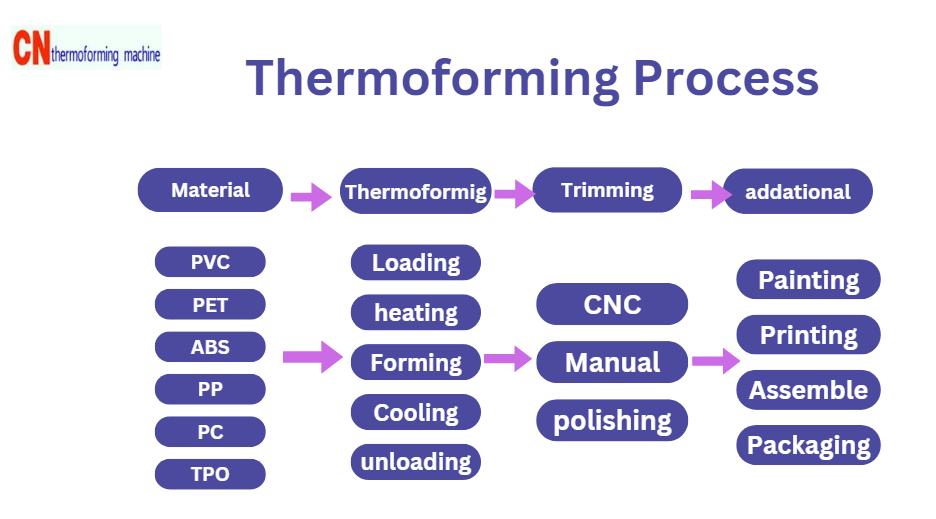How Thermoforming Works: Step-by-Step Overview
Thermoforming is a versatile manufacturing process used to mold plastic sheets into specific shapes using heat, pressure, or vacuum. This method is widely used in industries like automotive, packaging, and medical devices due to its cost-effectiveness and ability to create durable, lightweight components. Here’s a step-by-step breakdown of the thermoforming process:

1. Material Selection
The process begins with choosing the right thermoplastic material. Factors influencing the choice include:
- Material Properties: Strength, flexibility, heat resistance, and impact resistance.
- Application Requirements: Aesthetic appeal, durability, and environmental exposure.
Common materials include:
- ABS, PVC, PETG, HDPE, Polycarbonate, and TPO.
2. Preparing the Plastic Sheet
The thermoplastic sheet, typically ranging from thin (less than 1.5 mm) to thick (more than 3.0 mm) gauges, is cut to the required size.
3. Heating
The plastic sheet is heated to its forming temperature in a controlled environment:
- Heating Techniques:
- Radiant heaters (electric or gas-powered).
- Convection ovens for uniform heat distribution.
- Thermoforming Window: The temperature range where the sheet becomes pliable but not degraded.
4. Clamping
The softened plastic sheet is clamped securely in a frame to prevent movement during forming. This ensures proper stretching and uniform shaping.
5. Forming
The heated sheet is molded into the desired shape using one of these methods:
- Vacuum Forming: A vacuum draws the softened plastic over the mold surface.
- Pressure Forming: Compressed air forces the plastic against the mold for finer details.
- Mechanical Forming: Plugs or other tools assist in shaping complex geometries.
6. Cooling
The molded plastic part is cooled while still on the mold. Cooling can involve:
- Air Cooling: Simple and effective for many applications.
- Water Channels: Mold-integrated cooling for faster cycles.
- Fogging or Chilled Air: Used for precise temperature control.
Cooling ensures the material retains its shape and properties before removal.
7. Trimming and Finishing
Excess material is trimmed from the formed part using:
- CNC Trimming: High precision for complex shapes.
- Manual Trimming: For smaller or simpler parts.
- Edge Finishing: Smoothing or polishing edges for a professional appearance.
8. Inspection and Quality Control
Each part undergoes thorough inspection for:
- Dimensional Accuracy: Meets specified tolerances.
- Surface Quality: Free from defects like warping or bubbles.
- Material Integrity: Ensures strength and durability.
9. Recycling and Waste Management
- Scraps from the trimming process are collected and often recycled into new sheets or used for other applications.
10. Packaging and Shipping
The finished parts are cleaned, packaged, and shipped to customers for use in their respective applications.
Advantages of the Thermoforming Process
- Cost-Effective Tooling: Lower initial investment compared to injection molding.
- Versatility: Suitable for a wide range of part sizes and complexities.
- Fast Prototyping: Rapid design iterations and production of prototypes.
- Sustainability: Recycling capability for scrap materials.
Thermoforming is an efficient and scalable process that balances cost, flexibility, and performance. By understanding each step in detail, manufacturers can optimize production for a variety of industries and applications.
